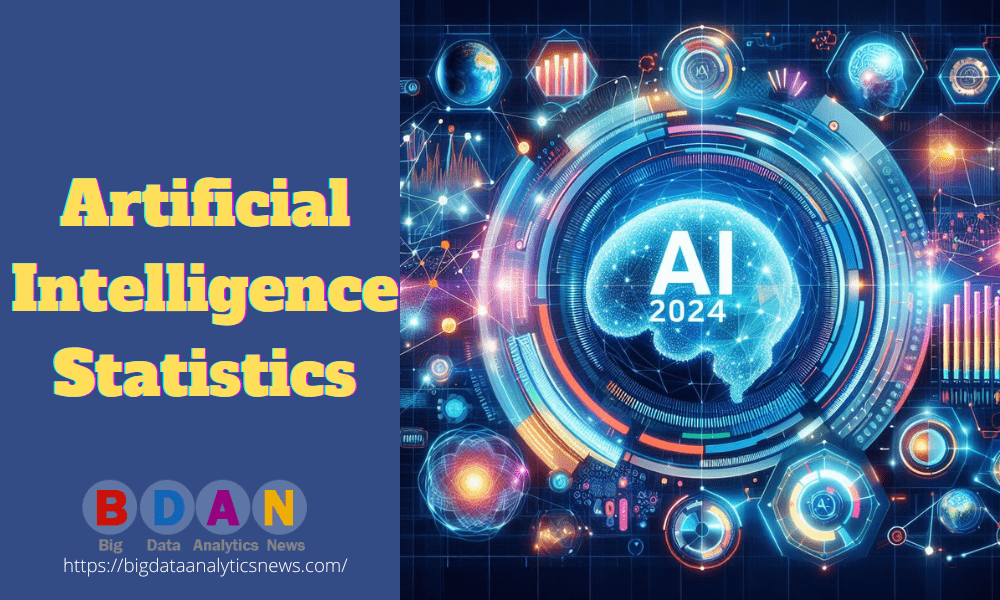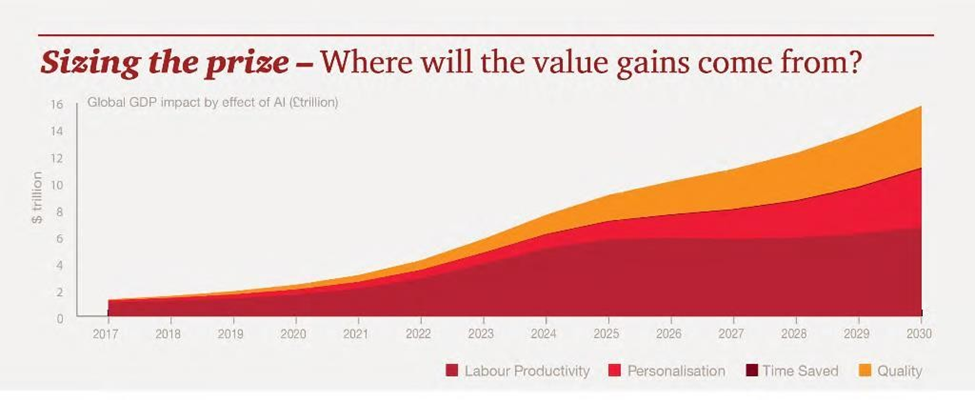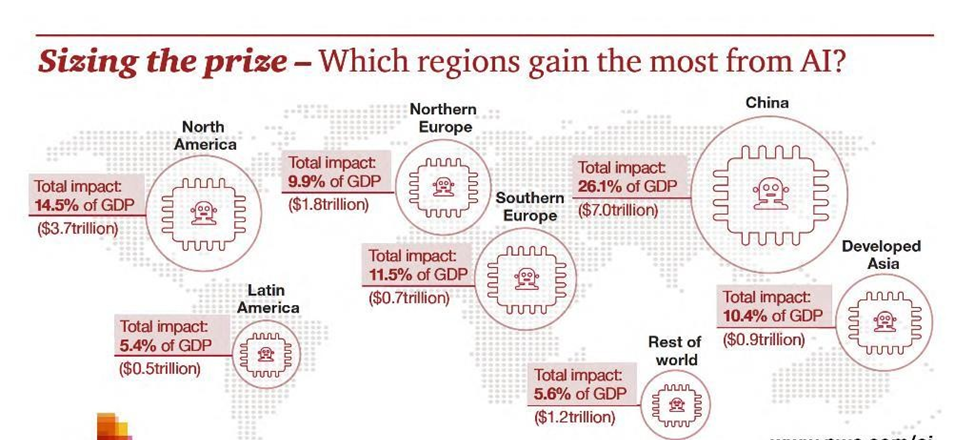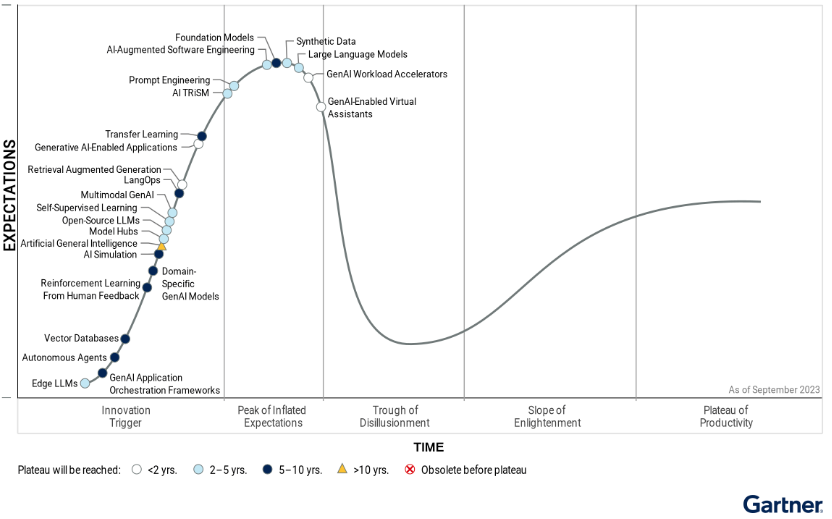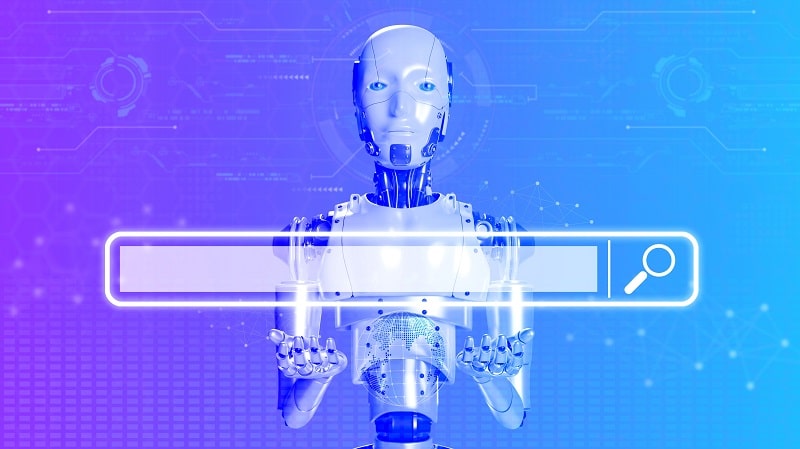Artificial Intelligence (AI) has emerged as a game-changer, sparking a revolution across industries and molding the fabric of our society. This blog post aims to present a profound glimpse into the landscape of AI statistics in 2024, unraveling significant trends, breakthroughs, and the profound influence of AI across diverse sectors. Through an exploration of statistical data, our objective is to provide a thorough and enlightening overview of the present dynamics and prospective developments in the realm of AI.
“We’re at the beginning of a golden age of AI and are solving problems that were once in the realm of science fiction.” – Jeff Bezos
In the ever-evolving landscape of technology, Artificial Intelligence (AI) stands as a beacon of innovation, transforming industries and shaping the future. As we step into 2024, let’s delve into the latest AI statistics that illuminate the current state and trajectory of this powerful technology.
Contents:
Top Artificial Intelligence Statistics (Top Picks 2024)
- The market size in the Artificial Intelligence market is projected to reach US$305.90bn in 2024.
- The market size is expected to show an annual growth rate (CAGR 2024-2030) of 15.83%, resulting in a market volume of US$738.80bn by 2030.
- In global comparison, the largest market size will be in the United States (US$106.50bn in 2024) (Source: Statista)
- 35% of businesses globally have adopted AI. In 2024, the AI market is anticipated to grow by 38%.
- AI will add an impressive 15.7 trillion dollars to the world’s GDP by 2030, growing it by 14%. The global AI market is expected to reach $1.81 trillion by 2030.
- By 2025, nearly 100 million people will be working in the AI sector, and the industry will generate 12 million new jobs by then.
- 32.9% of businesses have already replaced some human tasks with AI solutions.
- Nearly 20 million manufacturing jobs could be lost due to automation by 2030.
- China is the leader in AI adoption, with 58% of businesses deploying AI.
- Netflix makes $1 billion annually from automated personalized recommendations.
- 48% of businesses use some form of AI to utilize big data effectively.
- 38% of medical providers use computers as part of their diagnosis.
AI Global Market Size and its Forecast
By 2027, spending on AI software will grow to $297.9 billion, with a CAGR of 19.1%. Over the next five years, the market growth will accelerate from 17.8% to reach 20.4% in 2027. Generative AI software spend will rise from 8% of AI software in 2023 to 35% by 2027, according to Garter.
AI has the humongous potential to contribute to the global economy. AI is expected to contribute more than the current output of India and China combined, to the world economy by 2030.( PWC-Sizing The Price)
AI is expected to contribute $15.7 trillion to the global economy by 2030, more than the current output of China and India combined.( PWC-Sizing The Price)
The greatest economic gains from AI will be in China which will receive a boost of 26% rise to GDP in 2030, followed by North America (14.5% boost), totaling to $10.7 trillion and accounting for almost 70% of the global economic impact.
( PWC-Sizing The Price)
AI Evolution by ChatGPT
ChatGPT has offered a sneak peek into the world of AI, generating considerable excitement with its remarkable advancements. This innovative AI chatbot facilitates human-like conversations, swiftly responding to queries and assisting users with tasks like drafting emails, essays, and code. The impact of ChatGPT extends beyond mere conversation—it significantly influences employment dynamics and boosts productivity.
ChatGPT fastest growing app with 100 million active users
- OpenAI’s ChatGPT has taken off in record-breaking fashion. According to OpenAI, even Chat GPT, the most talked about AI tool, surpassed 10 lakh users in mere five days, after its launch in November,2022.(Statista)
- If we compare it to its peers, then it took Instagram nearly 2.5 months to reach 1 million downloads and Netflix around 3.5 years to reach 1 million users.( Statista)
- By January 2023, ChatGPT hit 100 million active users, making it the fastest-growing application in history.
Key Insights and Facts about ChatGPT
- According to Similarweb, openai.com receives nearly 1.8 billion visits per month.
- Almost 60% of ChatGPT’s social media traffic comes from YouTube, followed by WhatsApp, Facebook, Twitter and others.
- ChatGPT has a bounce rate of 17.33%.
- The most commonly google searched keyword is “chat gpt login” hitting nearly 6 million searches per month.
- The maximum proportion of ChatGPT users reside in the U.S. (15.22%) followed by India (6.32%), Japan (4.01%) and others.
Also see:
Top datasets to actualize machine learning and data training tutorial
How AI and Machine Learning Will Affect Machining
What Is Machine Learning and Where to Find the Best Courses?
Guide To Unsupervised Machine Learning: Use Cases
What Are Transformer Models In Machine Learning
Difference between Machine learning and Artificial Intelligence
Machine Learning Models in Production
Major companies in AI Market:
The number of AI-related Merger & Acquisitions deals has increased from less than 100 deals in 2016 to 500 in 2019, with Apple leading the US tech giants, followed by the rest of GAFAM alongside Intel and IBM. Top AI companies and big data analytics companies are focusing on developing AI products to increase market.
To keep up with the AI market, Here is the list of top 100 AI companies in the world, These top Artificial Intelligence companies, ai data analytics companies and big data companies playing a key role in shaping the future of AI.
Read more on Top 100+ AI Companies
Generative AI a growing market
In 2022, the release of ChatGPT 3.0 brought about a new awakening to the possibilities of generative artificial intelligence. A good understanding of this trend comes from observing the difference in interest in generative AI on Google, with interest growing rapidly from 2022 to 2023. It is to be expected that this interest will continue as both ChatGPT and others aim for updated chatbot versions in the future and further generative AI programs are in development.
Gartner Predicts 80% of Large Enterprise Finance Teams Will Use Internal AI Platforms by 2026
By 2026, more than 80% of enterprises will have used generative artificial intelligence (GenAI) application programming interfaces (APIs) or models, and/or deployed GenAI-enabled applications in production environments, up from less than 5% in 2023, according to Gartner, Inc.
The 2023 Gartner Hype Cycle for Generative AI identified key technologies that are increasingly embedded into many enterprise applications. Specifically, three innovations that are projected to have a huge impact on organizations within ten years include GenAI-enabled applications, foundation models and AI trust, risk and security management (AI TRiSM) (see Figure 1).
Figure 1: Hype Cycle for Generative AI, 2023
AI Growth Drivers:
With the rise of AI and its global applications, various sectors are experiencing growth, reshaping our vision of the future. Ongoing technological advancements, including wearable technology, chip market solutions, self-driving cars, and automated medical procedures, are significantly influencing market growth. Let’s explore how these growth drivers are poised to bring about substantial changes in the years ahead.
Rising AI Chip Market
- The global AI chip market size is set to reach $83.25 billion by 2027. It is expected to grow at a CAGR of 35% during 2019-2027.( Insight Partners)
- AI chips are largely used in automotive, healthcare, defense, IT and telecommunications sectors.
- North America dominates the global AI chip market, whereas Asia-Pacific is considered the fastest-growing region.( Insight Partners)
- Super-high bandwidth memory, speedy computation process and parallel faster processing are the plus points of AI chips.
Automotive Artificial Intelligence Market Size
- The self-driving car market is expected to increase from 20.3 million in 2021 to 13.7 billion by 2030. It is expected that 10% of vehicles will be driverless by 2030.
- Fully automated cars are expected to contribute some $13.7 billion by 2030.
- Robo-taxis are projected to become the top use case for driverless vehicles.(statista)
AI in Healthcare
- AI lifts up the healthcare segment by assisting in treatment, research, drugs discovery, diagnosis and decision making.
- Around half of the US-based healthcare providers are planning to deploy AI tools such as (Robotics Process Automation) RPA in their healthcare facilities by the end of 2023, says Gartner.
- AI in drug discovery is expected to cross $4 billion by 2027 at a CAGR of 45.7%.( MarketsAndMarkets)
- The global RPA market in the healthcare market size is expected to rise to $6.2 billion by 2030 at a CAGR of 26.01%. The global RPA market size was evaluated at $2.9 billion in 2022.( Precedence Research)
- The medical robot market is expected to grow at a CAGR of 17.4% between 2022 to 2032. The medical robot market share is projected to reach the value of $40 billion by 2032.( Precedence Research)
AI Function Statistics:
There are over 4 billion voice assistants currently in use (BusinessWire)
Chatbots may still need improvements in natural language processing before consumers are on board. But voice assistants are a prime example of AI merging seamlessly with everyday life.
Here is the number of digital voice assistants in use worldwide from 2019 to 2024:
| Year | Number of Digital Voice Assistants |
| 2019 | 3.25 billion |
| 2020* | 4.2 billion |
| 2024* | 8.4 billion |
*Projected figures.
By 2024, voice assistants equipped with natural language processing technology may outnumber the human race at 8.4 billion devices.
More than half of Americans use voice assistants for information purposes (Edison Research)
Over 110 million virtual assistant users reside in the US.
And as of early 2020, voice assistants were a source of information for 51% of all US residents.
By the end of 2023, the NLP market share is forecast to increase to over $43 billion (Tractica)
Natural language processing (NLP) helps computers translate human language into information they understand by manipulating data.
Companies are striving to bridge the gap between human language and machine intelligence.
Here’s a look at global revenue from the NLP market from 2017 to 2025:
| Year | Revenue |
| 2017 | $3.18 billion |
| 2018 | $5.07 billion |
| 2019* | $8.21 billion |
| 2020* | $12.4 billion |
| 2021* | $17.58 billion |
| 2022* | $24 billion |
| 2023* | $30.35 billion |
| 2024* | $37.33 billion |
| 2025* | $43.29 billion |
*Projected figures
During the forecast period of 2017-2025, the NLP market is set to grow by around 14x.
Whatsapp produces over 100 billion AI-processed messages each day (Backlinko)
WhatsApp is the most popular messaging app in the world. AI helps process more than 100 billion messages every day.
Global AI Adoption: Artificial Intelligence Growth
How Businesses Adopt Artificial Intelligence
The worldwide embrace of AI by enterprises has experienced over a twofold increase since 2017, displaying a robust growth trajectory that suggests even more promising trends in the years ahead. As per a survey report by IBM, companies in India and China are emerging as frontrunners in AI adoption, outpacing their counterparts in other technologically advanced nations. Let’s delve into the statistics concerning the global landscape of AI adoption.
- In the year 2017, 20% of respondents reported adopting AI in at least one business area, whereas in 2022, that figure stands at 50%, though it peaked higher in 2019 at 58%. (McKinsey Report)
- Global AI adoption rate plateaued steadily and now is 35% in 2022, which is a four-point increase from the year before..( IBM Global AI Adoption Report)
- 44% of organizations are working to embed AI into current applications and processes and two-thirds of companies are already or are planning to apply AI to their sustainability-related goals. .( IBM Global AI Adoption Report)
- Around 4 in 5 companies deem AI to be a top priority in their business strategy (Forbes)
- 80% of retail executives expect their businesses to adopt AI automation by 2025 (Analytics Insight)
- AI is helping manufacturing companies outperform competitors (Microsoft)
- 19 in every 20 customer interactions will be AI-assisted by 2025 (AI Business)
Chinese and Indian Companies Lead in AI Adoption
- According to an IBM report, Chinese and Indian companies lead in AI adoption, with almost 60% of IT professionals saying their organization already uses AI applications.( IBM Global AI Adoption Report)
- IT spending in AI is projected to see an annual growth rate of around 27% from 2021 to 2026.( IDC Worldwide)
Also see:
Top 20 Artificial Intelligence Platforms for 2024
Difference between Machine learning and Artificial Intelligence
Artificial Intelligence: Automating Hiring Process For Businesses!
Top 5 Hidden Artificial Intelligence Technology
Artificial Intelligence: What Can We Expect Next?
AI in Marketing, Sales statistics:
Netflix’s AI recommendation engine generates $1 billion in revenue every year
Netflix has incorporated AI in its applications and websites. The ML technology that Netflix uses has impacted a large percentage of its revenue. Netflix’s AI-powered personalized recommendation engine pulls in around $1 billion annually. Source: Business Insider
71.2% Of Marketers Believe Using AI Will Help Them Run Campaigns Effectively
- 76% of marketers use generative AI for basic content creation and copywriting.
- 19.2% of marketers spent more than 40% of their marketing budget on AI-driven campaigns.
- 71.2% believe AI can outperform humans at their jobs.
Source: insiderintelligence
62% Of Consumers Trust AI-Created Content
- 62% of consumers are confident using generative AI in marketing and advertising.
- 64% of consumers are willing to buy a new product suggested by generative AI.
Source: Capgemini
Companies Are Using AI For Sales
- 26% of organizations use AI for marketing and sales, with 22% using conversational AI or virtual assistants specifically. Source: IBM
- Marketing and sales departments prioritize AI and ML for market revenue success 40% more than other industry departments (Forbes)
- AI algorithms increase leads by as much as 50% (Harvard Business Review
- Around 4 in 10 marketers believe that AI email marketing improves market revenue (Statista)
AI Tools and their Potential
AI has the capability to replicate human tasks and, notably, execute them without errors. AI tools and automation solutions play a crucial role in enhancing business productivity, ensuring the timely delivery of promising outcomes. The data presented below illustrates how AI-powered tools, including deep learning and machine learning, hold the potential to enhance productivity, improve efficiency, and elevate the overall customer service experience.
AI Improves Productivity by Automating Repetitive Tasks
- According to PWC, AI is expected to improve productivity by 40% by 2035.
- 52% of telecommunications organizations utilize chatbots to increase their overall productivity and 38% of healthcare providers rely on computer-assisted diagnostics.(Gartner)
- To maintain the accuracy and error-free data, 48% of businesses are optimizing the use of machine learning (ML), data analysis, and several other AI tools.( Orilley.com)
- According to Forbes Advisor, 64% of business owners believe AI improves customer relationships and thus helps in enhancing client interactions.(forbes advisor)
AI Challenges:
- Job loss is a primary concern for AI skeptics (Tractica)
- Elon Musk warns that AI services could overtake humans by 2025 (Independent)
- Around 3 in 4 CEOs worry about limited transparency in the AI market (PwC)
- A 2017 survey found that 76% of CEOs worry about the lack of transparency and the potential of skewed biases in the global AI market.
- 4 in 10 executives believe AI is prohibitively expensive (Harvard Business Review)
- However, 40% of executives agree that advanced AI technologies and the experts who run them are currently too expensive to implement.
Artificial Intelligence (AI) holds immense potential, but it also presents several challenges that need to be addressed for its successful implementation and integration. Here are some of the key challenges in AI:
- Computing Power: AI algorithms, particularly those used in Machine Learning and Deep Learning, require substantial computational resources. The need for high-performance hardware can be a barrier, especially for complex tasks that require supercomputers.
- Trust Deficit: The ‘black box’ nature of AI models can lead to a trust deficit. It’s often unclear how these models arrive at their predictions or decisions, which can lead to skepticism and reluctance to adopt AI solutions. (upgrad.com)
- Lack of Understanding: AI is a relatively new field, and there’s still much we don’t understand about its inner workings. This lack of understanding can hinder the development of reliable and accurate AI systems. (dataconomy)
- Ethical Challenges: AI adoption brings with it a host of ethical challenges, including concerns about privacy, bias, transparency, and accountability.(itrexgroup)
- Reproducibility: AI models often fail to reproduce lab results in real-world scenarios, which can be a significant hurdle in scaling AI systems across use cases.
- Job Loss Concerns: There are concerns that AI could lead to job losses as automation replaces certain roles, leading to social and economic issues.(educba)
Addressing these challenges requires careful consideration, strategic approaches, and ongoing research and development efforts. As we continue to advance in the field of AI, it’s crucial to navigate these challenges effectively to harness the full potential of AI.
Wrapup
The AI market is undeniably poised for a bright and lucrative future. Despite worries surrounding job displacement, evidence indicates that AI technology will actually contribute to the establishment of additional startups and job opportunities, outweighing the jobs it might eliminate. This is attributed to AI’s proficiency in executing tasks when provided with abundant data and information through programming by humans. Consequently, AI emerges as an essential and irreplaceable component of the modern technology ecosystem.
For more related content, check out Top Big Data Statistics, Top AI Platforms and Machine Learning trends.
